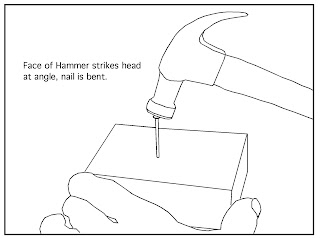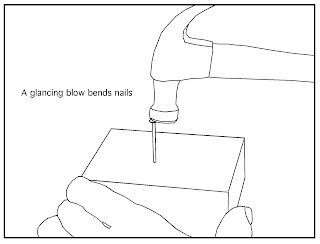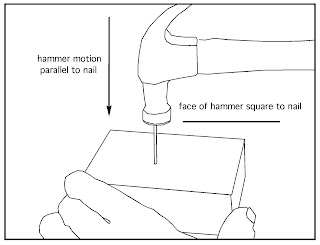 A person might not ever want to know how to deliberately bend a nail, but if he or she does know why they bend, bent nails can be more consciously avoided. I was intrigued by Joe Youcha's use of the hammer in a discussion of physics. So I did these three drawings to show how to bend a nail, or not.
A person might not ever want to know how to deliberately bend a nail, but if he or she does know why they bend, bent nails can be more consciously avoided. I was intrigued by Joe Youcha's use of the hammer in a discussion of physics. So I did these three drawings to show how to bend a nail, or not. The first drawing shows what could be described as an "angle of incidence". If a hammer strike is not dead on in the direction one intends the nail to travel into the wood, it presents a lateral force, bending the nail. The second drawing shows a glancing blow that is roughly equivalent to two cars striking head-on, but off center. A bent nail is the result. The third drawing shows the face of the hammer striking the nail at the correct angle and with the nail at the center of the hammer face where the greatest direct force is conveyed. Unless the nail hits a knot or is being driven into wood too hard for the use of nails, it should go in straight. Learning to hammer, is not just a matter of the physics of the hammer, it is also a matter requiring close observation of self. In driving a nail, a kid's posture makes a difference. Working on a low bench or even on the floor allows the hammer to have greater force. The smooth motion of the arms is required and so the physical parameters of self come into play. These come from analysis and experience but the analysis need not be verbal.
The first drawing shows what could be described as an "angle of incidence". If a hammer strike is not dead on in the direction one intends the nail to travel into the wood, it presents a lateral force, bending the nail. The second drawing shows a glancing blow that is roughly equivalent to two cars striking head-on, but off center. A bent nail is the result. The third drawing shows the face of the hammer striking the nail at the correct angle and with the nail at the center of the hammer face where the greatest direct force is conveyed. Unless the nail hits a knot or is being driven into wood too hard for the use of nails, it should go in straight. Learning to hammer, is not just a matter of the physics of the hammer, it is also a matter requiring close observation of self. In driving a nail, a kid's posture makes a difference. Working on a low bench or even on the floor allows the hammer to have greater force. The smooth motion of the arms is required and so the physical parameters of self come into play. These come from analysis and experience but the analysis need not be verbal. A person can learn to hammer nails successfully without ever coming to an elaborate mental and verbal analysis of the geometry or physics involved. In fact, millions of successful carpenters have been able to do so. On the other hand, one might know all the physics and geometry and more, and really know almost nothing about how to drive a nail. Can you see how there might be advantages to both knowing the physics and math and having real experience driving the nail? Unfortunately the education of American school children is aimed at the passive acquisition of knowledge, not toward the active expression of it.
A person can learn to hammer nails successfully without ever coming to an elaborate mental and verbal analysis of the geometry or physics involved. In fact, millions of successful carpenters have been able to do so. On the other hand, one might know all the physics and geometry and more, and really know almost nothing about how to drive a nail. Can you see how there might be advantages to both knowing the physics and math and having real experience driving the nail? Unfortunately the education of American school children is aimed at the passive acquisition of knowledge, not toward the active expression of it.I plan to use these drawings to help my first, second and third grade students understand why nails bend. If I can give them greater observational powers, they will become better craftsmen, but also better mathematicians and scientists at the same time.
Time Magazine this week has an article, The Reason for Recess about schools once again realizing that the body needs exercise for the proper functioning of the brain. This was an idea held by Otto Salomon in his teaching of Educational Sloyd, and I was surprised when I visited at Nääs, Sweden and learned the strong role of physical education in the methods prescribed there. According to the article in Time,
"Physical activity can improve blood flow to the brain, fueling memory, attention and creativity, which are essential to learning. And exercise releases hormones that can improve mood and suppress stress, which can help learning."Salomon and others from progressive education believed that learning should be "all sided" in that it should engage the child's physical nature as well as his or her intellectual side.
Make, fix and create...
I think you have the thumb too far from where the nail is going to land in those drawings!
ReplyDeleteMario
Mario, I will do another post on how to smack your thumb later. I have drawings to illustrate that, too.
ReplyDelete